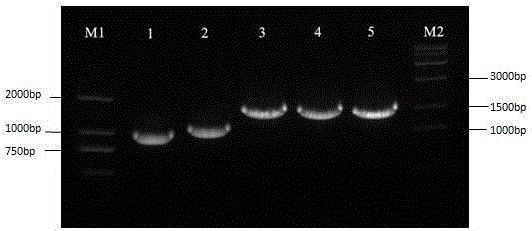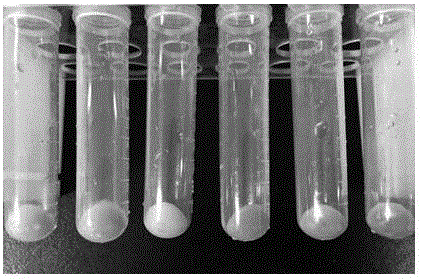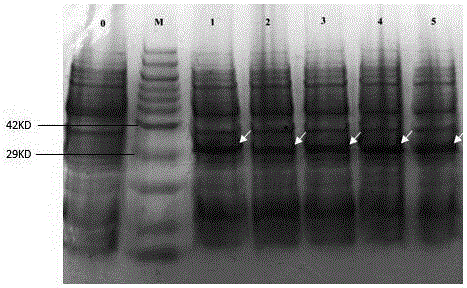Gene engineering strain for expressing phycocyanobilin and constructing method and application thereof
A technology of genetically engineered strains and phycocyanin, which is applied in the fields of molecular biology technology and bioengineering, can solve problems such as lack of research on effects, and achieve the effect of broad market application prospects.
- Summary
- Abstract
- Description
- Claims
- Application Information
AI Technical Summary
Problems solved by technology
Method used
Image
Examples
Embodiment 1
[0032] Embodiment 1: Cloning of hoxI gene and pcyA gene in Arthrospira platensis FACHB314
[0033] 1. Cloning of hoxI gene in Arthrospira platensis FACHB314
[0034] Arthrospira platensis FACHB314 belongs to the health care product and has application value in food and medicine. It was purchased from the Freshwater Algae Species Bank (FACHB) of the Wild Biology Germplasm Bank of the Chinese Academy of Sciences, and commercially available Arthrospira platensis can also be used.
[0035] Primers hoxI-1 and hoxI-2 were designed, and BamHI and SacI sites were introduced into the primers hoxI-1 and hoxI-2 respectively (underlined enzyme cleavage sites). The primer sequences are:
[0036] hoxI-1 5'- GGATCC ATGAGTGTTAACCTAGCCACCCA-3';
[0037] hoxI-2 5'- GAGCTC TTAGTTCACCGAGTCAGTAGCG-3'.
[0038] A PCR reaction was performed using the genome sequence of Arthrospira platensis FACHB314 as a template. The PCR reaction procedure was: pre-denaturation at 94°C for 5 min; denaturatio...
Embodiment 2
[0051] Example 2: Establishment of recombinant expression strain H(314)P(314)
[0052] The pMD19T-hox I (314) and pMD19T-pcyA (314) of the obtained positive clone plasmids were double-digested with BamHI and SacI and SacI and SalI respectively, and the target fragment was recovered by tapping to obtain the hoxI (314) gene and pcyA ( 314) gene, and connect the two into the pET24a(+) empty vector, first use the enzyme cutting sites BamHI and SacI of the hoxI(314) gene to digest the pET24a(+) empty vector, so that the hoxI( 314) The gene was ligated in first to obtain pET24a-hoxI (314). Then pET24a-hoxI(314) was digested with the enzyme cutting sites SacI and SalI of the pcyA(314) gene, so that the pcyA(314) gene was also connected into the expression vector to obtain the recombinant expression plasmid pET24a-hoxI(314) -pcyA(314).
[0053] The plasmid was transformed into E.coli DH5α, and was screened with a plate containing Kan resistance, and positive strains were obtained th...
Embodiment 3
[0068] Example 3: Induced expression and SDS-PAGE of recombinant expression strains H(314), P(314), H(314)P(314), H(6803)P(314), H(314)P(6803)
[0069] 1. Induced expression of recombinant strains:
[0070](1) Inoculate five constructed recombinant expression strains H(314), P(314), H(314)P(314), H(6803)P(314), H(314)P(6803) into In LB liquid medium (containing the antibiotic Kan); at the same time, inoculate the blank control E.coli BL21(DE3) without expression vector, without antibiotics in the medium, and culture overnight at 37°C for 12-14h;
[0071] (2) Inoculate the overnight cultures of the above five recombinant expression strains in 100ml (containing Kan) LB liquid medium at a ratio of 1:100; inoculated in 100ml LB medium without antibiotics, cultured at 37°C for 2-3 hours to OD 600 ≈0.6;
[0072] (3) At 37°C, add isopropylthio-β-D-galactoside (IPTG) to a working concentration of 1 mmol / L;
[0073] (4) After induction at 37°C for 2 hours, measure the OD of the thr...
PUM
| Property | Measurement | Unit |
|---|---|---|
| Molecular weight | aaaaa | aaaaa |
| Molecular weight | aaaaa | aaaaa |
Abstract
Description
Claims
Application Information
 Login to View More
Login to View More - R&D
- Intellectual Property
- Life Sciences
- Materials
- Tech Scout
- Unparalleled Data Quality
- Higher Quality Content
- 60% Fewer Hallucinations
Browse by: Latest US Patents, China's latest patents, Technical Efficacy Thesaurus, Application Domain, Technology Topic, Popular Technical Reports.
© 2025 PatSnap. All rights reserved.Legal|Privacy policy|Modern Slavery Act Transparency Statement|Sitemap|About US| Contact US: help@patsnap.com



